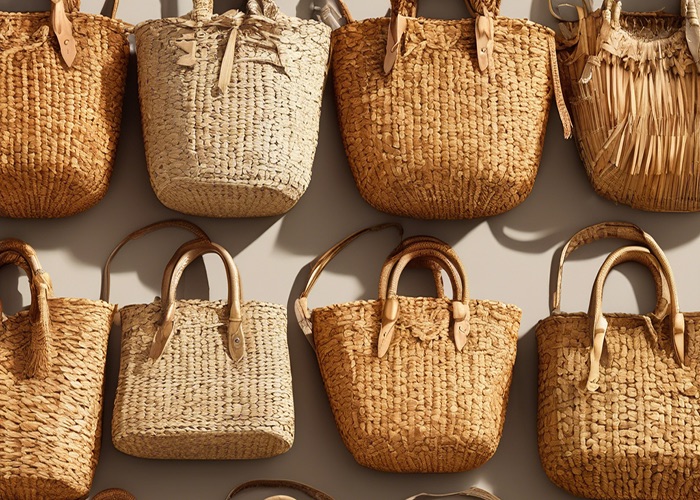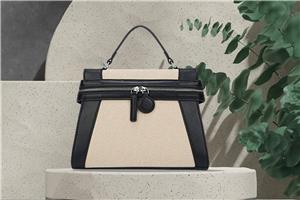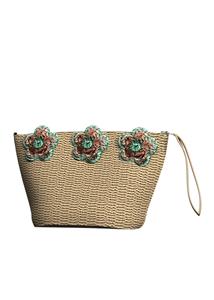How to Choose the Perfect Straw Bag: A Comprehensive Guide to Quality and Style
How to Choose the Perfect Straw Bag:
A Comprehensive Guide to Quality and Style
The Timeless Appeal of Straw Bags
Straw bags have been a beloved accessory for generations, effortlessly blending functionality with a touch of whimsy. These versatile carriers have transcended their humble origins to become fashion staples, gracing the arms of style icons like Jane Birkin and everyday fashionistas alike. The enduring charm of straw bags lies in their ability to evoke a carefree, summery vibe while complementing a wide array of outfits.
What sets straw bags apart is their unique texture and natural aesthetic. The woven patterns and earthy tones add depth and interest to any ensemble, whether you're strolling along a beach boardwalk or navigating city streets. This adaptability makes them a go-to choice for those seeking a balance between casual and chic, embodying both bohemian style and retro fashion elements.
Moreover, the sustainability factor of straw bags has contributed significantly to their ongoing popularity. As consumers become increasingly eco-conscious, the appeal of accessories crafted from renewable resources has soared. Straw bags, often made from biodegradable materials, offer a guilt-free fashion option that aligns with environmentally friendly values.
Materials Matter: Natural vs. Synthetic Straw
When selecting a straw bag, one of the first considerations is the material used in its construction. The choice between natural and synthetic straw can significantly impact the bag's appearance, durability, and overall quality. Let's explore the characteristics of each:
Natural Straw:
Raffia: Derived from palm leaves, raffia offers a soft, pliable texture and natural sheen, making it perfect for a raffia bag.
Seagrass: Known for its durability and resistance to water damage, ideal for beach bags.
Jute: Provides a rustic look and is highly sustainable.
Rattan: Offers a sturdy structure and intricate weaving patterns, popular for rattan straw bags.
Synthetic Straw:
Polypropylene: Mimics the look of natural straw while offering increased durability.
PVC: Provides water resistance and comes in a variety of colors.
Nylon: Lightweight and often used in combination with natural fibers for added strength.
While natural straw bags boast authenticity and eco-friendliness, synthetic options often provide enhanced durability and resistance to the elements. Your choice may depend on how you plan to use the bag and your personal preferences regarding sustainability and maintenance.
Types of Straw Bags: From Totes to Clutches
Straw bags come in a diverse array of styles, each suited to different occasions and personal tastes. Understanding the various types available will help you make an informed decision when selecting your perfect straw companion:
Tote Bags: Spacious and practical, straw tote bags are ideal for beach outings or as everyday carryalls. They often feature sturdy handles and a roomy interior, perfect for holding essentials and then some. A straw beach bag or beach tote is a must-have for summer adventures.
Crossbody Bags: These versatile options offer hands-free convenience with adjustable straps. They're great for running errands or casual day trips.
Clutch Bags: Elegant and compact, straw clutches add a touch of bohemian flair to evening looks or special events.
Bucket Bags: With their distinctive shape and drawstring closure, bucket bags in straw offer a trendy alternative to traditional styles.
Backpacks: Combining functionality with a laid-back aesthetic, straw backpacks are perfect for those who prefer a more balanced weight distribution.
When choosing among these styles, consider your lifestyle and the primary purpose of the bag. A tote might be ideal for those who carry many items daily, while a clutch could be the perfect choice for minimalists or for special occasions.
Assessing Straw Bag Quality: What to Look For
Determining the quality of a straw bag requires attention to detail and a discerning eye. Here are key factors to consider when evaluating the craftsmanship and durability of your potential purchase:
Weave Tightness and Consistency
Examine the weave of the bag closely. The best straw bag will have a tight, uniform weave throughout. Look for evenness in the pattern and ensure there are no loose strands or gaps in the weaving. This not only affects the bag's appearance but also its structural integrity.
Reinforcement and Lining
Check for reinforced areas, especially at stress points like handles and corners. Quality straw bags often feature leather straps or fabric reinforcements to enhance durability. Additionally, a well-made lining can protect your belongings and maintain the bag's shape over time.
Hardware and Closures
Pay attention to the quality of any metal hardware, such as zippers, clasps, or decorative elements. These should be securely attached and rust-resistant. Closures should function smoothly and effectively to keep your belongings safe. A straw bag with zipper offers extra security for your items.
Stitching and Finishing
Inspect the stitching along seams and edges. It should be even, tight, and free from loose threads or fraying. The overall finishing of the bag, including any decorative elements or embellishments, should be neat and well-executed.
By carefully assessing these aspects, you can ensure that your chosen straw bag not only looks great but also stands the test of time and use.
Style Considerations: Choosing the Right Shape and Size
Selecting the perfect straw bag involves more than just material and quality; the shape and size play crucial roles in complementing your style and meeting your practical needs. Here's how to navigate these important factors:
Shape Matters
The shape of your straw bag can dramatically influence your overall look:
Round bags: Offer a playful, vintage-inspired vibe that pairs well with feminine dresses and skirts.
Rectangular totes: Provide a more structured look, suitable for both casual and semi-formal occasions.
Asymmetrical designs: Add an artistic flair to your outfit, perfect for those who enjoy making a statement.
Consider how the bag's silhouette aligns with your personal style and the types of outfits you typically wear.
Size Considerations
Choosing the right size depends on your daily needs and the bag's intended use:
Size | Best For | Typical Contents |
|---|---|---|
Small (Clutch/Mini) | Evening events, minimal essentials | Phone, wallet, keys, lipstick |
Medium (Crossbody/Bucket) | Day trips, casual outings | Above + sunglasses, small water bottle, light sweater |
Large (Tote/Backpack) | Beach days, shopping trips | Above + towel, books, snacks, extra clothing |
Remember that while larger bags offer more storage, they can become cumbersome if overpacked. Strike a balance between capacity and comfort.
Proportion and Body Type
The size and shape of your straw bag should complement your body type:
Petite frames often benefit from smaller or medium-sized bags to maintain proportion.
Taller individuals can carry larger bags without being overwhelmed by the size.
Consider the length of handles or straps to ensure the bag sits comfortably at your preferred position.
By carefully considering these style elements, you'll be able to select a straw bag that not only meets your practical needs but also enhances your personal aesthetic.
Caring for Your Straw Bag: Maintenance Tips
To ensure your straw bag remains a cherished accessory for years to come, proper care and maintenance are essential. Follow these tips to keep your bag looking its best:
Storage: Store your straw bag in a cool, dry place away from direct sunlight to prevent fading and weakening of the fibers.
Cleaning:
Gently brush off dirt and dust with a soft-bristled brush.
For deeper cleaning, use a damp cloth with mild soap, being careful not to saturate the straw.
Allow the bag to air dry completely before use or storage.
Reshaping: If your bag loses its shape, stuff it with tissue paper while damp to help it regain its original form as it dries.
Moisture Protection: Apply a light coat of water-repellent spray designed for natural fibers to protect against unexpected splashes.
Avoid Overloading: Respect the bag's capacity to maintain its structure and prevent strain on the weave and handles.
By incorporating these care practices into your routine, you'll extend the life of your straw bag and keep it looking fresh season after season.
Styling Your Straw Bag: Versatility in Action
One of the greatest attributes of a well-chosen straw bag is its versatility. Here are some inspiring ways to incorporate your summer straw bags into various looks:
Casual Chic
Pair a medium-sized straw tote with high-waisted jeans, a crisp white t-shirt, and espadrille wedges for a polished yet relaxed daytime look.
Beach Ready
Match a large straw beach bag with a flowing maxi dress, oversized sunglasses, and sandals for the perfect seaside ensemble.
Office Appropriate
Choose a structured straw bag with leather trim to complement a tailored blazer, slim-fit trousers, and pointed flats for a unique twist on workwear.
Evening Elegance
Opt for a small straw clutch with metallic accents to add texture to a sleek cocktail dress and strappy heels for summer soirées.
Festival Fun
Rock a cute straw bag with denim shorts, a bohemian blouse, and ankle boots for a free-spirited festival vibe.
Remember, the key to styling your straw bag is to let it be a standout accessory while complementing your overall look. Don't be afraid to experiment with different combinations to find what works best for your personal style.
Making an Eco-Friendly Choice
In today's environmentally conscious world, selecting a straw bag can be a step towards more sustainable fashion choices. Here's how to ensure your purchase aligns with eco-friendly values:
Sustainable Materials
Opt for bags made from rapidly renewable resources such as bamboo, seagrass, or sustainably harvested raffia. These natural materials have a lower environmental impact compared to synthetic alternatives.
Ethical Production
Look for brands that prioritize fair labor practices and support artisanal communities. Many straw bags are handmade bags, providing employment opportunities in rural areas. Artisan crafted pieces often have unique character and support traditional craftsmanship.
Longevity
Choose a high-quality bag designed to last. A durable straw bag that withstands multiple seasons reduces the need for frequent replacements, minimizing waste.
Versatility
Select a style that can be used in various settings. A bag that transitions well from casual to semi-formal occasions will get more use, justifying its environmental footprint. Consider a packable straw bag for easy transport during travels.
End-of-Life Considerations
Consider what will happen to the bag when it's no longer usable. Natural straw bags are often biodegradable, while those with synthetic components may require special disposal.
By keeping these factors in mind, you can enjoy your straw bag knowing it's a choice that supports both style and sustainability.
Ready to find your perfect straw bag? Armed with the knowledge from this comprehensive guide, you're now equipped to make an informed choice that aligns with your style, needs, and values. Whether you're heading to the beach, the office, or a night out, the right straw bag is waiting to become your go-to accessory. From functional beach bags to elegant clutch bags, and even the iconic straw Birkin bag inspired by Jane Birkin herself, there's a perfect straw purse for every occasion. Start your search today and step into summer with confidence and flair!
Summary
This comprehensive guide provides detailed insights on how to choose the perfect straw bag, considering quality, style, functionality, and sustainability.
Straw bags are timeless fashion staples, loved for their unique texture, natural aesthetic, and sustainability factor. Their versatility allows them to complement a wide array of outfits, from beach casual to city chic.
Materials used in their construction can be natural like Raffia, Seagrass, Jute, and Rattan or synthetic such as Polypropylene, PVC, and Nylon. While natural straw bags have an authentic look and are eco-friendly, synthetic straw bags often provide enhanced durability and resistance to elements.
Straw bags come in diverse styles including but not limited to Tote Bags, Crossbody Bags, Clutch Bags, Bucket Bags, and Backpacks. Each style serves different purposes and suits different occasions.
Quality assessment requires a keen eye for detail. Factors to consider include the tightness and consistency of the weave, reinforcement and lining, hardware and closures, and stitching and finishing.
Style is also a crucial aspect. The shape and size of the bag can dramatically influence the overall look. It's also important to select a straw bag that complements the body type and personal aesthetic.
Proper care and maintenance of the bag are essential to maintain its quality. This involves storing the bag in a cool, dry place, gentle cleaning, reshaping if needed, applying moisture protection, and avoiding overloading.
Finally, in today's environmentally conscious world, straw bags offer a step towards more sustainable fashion choices. Opting for bags made from sustainable materials, produced ethically, designed to last, versatile in use, and eco-friendly at the end of life, can contribute to a sustainable fashion industry.
Whether heading to the beach, the office, or a night out, the right straw bag can become a go-to accessory, adding a touch of summer to any outfit.
Q&A for the guide includes factors to consider when choosing a straw bag, benefits of choosing a straw bag made from natural materials, how to ensure the quality of a straw bag, and how to care for and maintain a straw bag.
Q&A:1. What are the major factors to consider when choosing a straw bag?
The key factors to consider when choosing a straw bag include the material (natural or synthetic straw), the type of bag (tote, crossbody, clutch, bucket, or backpack), the quality of the bag (weave tightness, reinforcement, hardware, and stitching), and the style (shape, size, and proportion). You should also consider the bag's care and maintenance requirements.
Q&A:2. What are the benefits of choosing a straw bag made from natural materials?
Natural straw bags offer authenticity and eco-friendliness. They are often made from renewable resources like raffia, seagrass, jute, or rattan, which are biodegradable and align with environmentally friendly values. However, they may require more care and maintenance than synthetic straw bags.
Q&A:3. How can I ensure the quality of a straw bag?
To ensure the quality of a straw bag, pay attention to the weave tightness and consistency, reinforcement and lining, hardware and closures, and stitching and finishing. A high-quality straw bag will have a tight, uniform weave, reinforced areas, secure and rust-resistant hardware, and even, tight stitching.
Q&A:4. How can I care for and maintain my straw bag?
To care for your straw bag, store it in a cool, dry place away from direct sunlight. Clean it gently with a soft-bristled brush or a damp cloth with mild soap. If the bag loses its shape, stuff it with tissue paper while damp to help it regain its original form. You can also apply a light coat of water-repellent spray designed for natural fibers for extra protection.





